Chongsheng Temple Three Pagodas Cultural Tourism Area is located in Dali City, Dali Bai Autonomous Prefecture, Yunnan Province, about 1.8 kilometers north of the ancient city of Dali. It is a national 5A-level tourist attraction that integrates the scenery of Cangshan and Erhai Lake, cultural relics, Buddhist culture, and leisure vacations. The scenic area covers an area of 1,000 mu (approximately 66.67 hectares), with a protection and utilization area of 5.68 square kilometers.
Historical Culture
The Three Pagodas of Chongsheng Temple were first built during the Kaiyuan period of the Tang Dynasty (713-741 AD) and flourished in the Song Dynasty (960-1279 AD). They are renowned worldwide for five major treasures: the Three Pagodas, the Jianji Giant Bell, the Yutong Guanyin Statue, the "Buddha Capital" plaque, and the Three Sage Gold Statues. Nine kings of the Dali Kingdom once became monks and practiced here, making it a famous royal temple of the Nanzhao and Dali Kingdoms. During the Xianfeng and Tongzhi periods of the Qing Dynasty (1851-1874 AD), Chongsheng Temple was destroyed by wars and natural disasters, leaving only the Three Pagodas intact. The Nanzhao Jianji Giant Bell was recast in 1997, the Yutong Guanyin Statue in 1999, and the ancient architectural complex of Chongsheng Temple was restored and reconstructed in 2005.
Main Attractions
Three Pagodas of Chongsheng Temple
The Three Pagodas consist of one large pagoda and two smaller ones. The large pagoda, called Qianxun Pagoda, whose full name is "Fajie Tongling Mingdao Cheng Pagoda", is 70 meters away from each of the two smaller pagodas (located to the north and south). The three pagodas form a tripod shape, with a unified layout, harmonious design, and an integrated appearance. Qianxun Pagoda was built during the reign of Quanfengyou of the Nanzhao Kingdom (823-859 AD). It is a 16-story square hollow brick pagoda with a dense-eave structure, standing 69.13 meters high, and is a typical example of Tang Dynasty architectural style. The two smaller north and south pagodas, built during the reigns of Duan Zhengyan and Duan Zhengxing of the Dali Kingdom (1108-1172 AD), feature a typical Song Dynasty architectural style. They are 97 meters apart from each other, each 42.19 meters high, and are 10-story octagonal brick pagodas with a dense-eave structure.
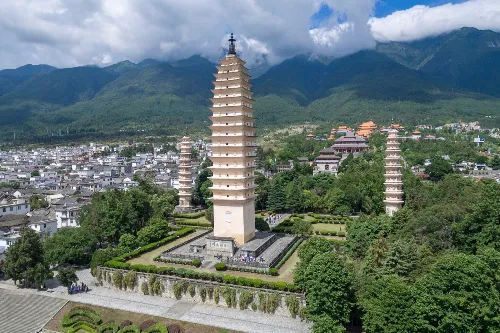
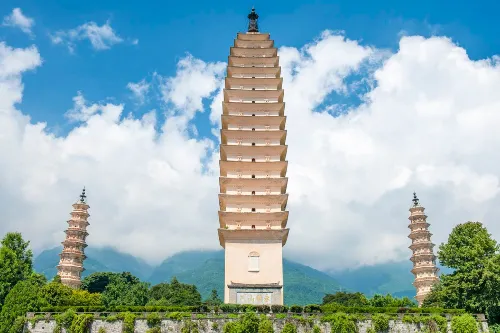
Chongsheng Temple
The temple was restored and reconstructed in 2005. Its overall layout includes three main and secondary axes, eight platforms, nine courtyards, and eleven levels. In terms of architectural style, it integrates the essence of architectural designs from the Tang, Song, Yuan, Ming, and Qing dynasties. Along the main central axis, there are successively the Mountain Gate, Release Pond, Jieting Bridge, Heavenly Kings Hall, Maitreya Hall, Eleven-faced Guanyin Hall, Mahavira Hall, Acarya Guanyin Pavilion, Shanhai Grand View Stone Archway, and Sea-Viewing Pavilion. The 617 Buddha statues and ritual implements in the temple are all cast in bronze, using more than 1,000 tons of copper. Among them, 599 Buddha statues and ritual implements are gilded and painted, setting a record in China.
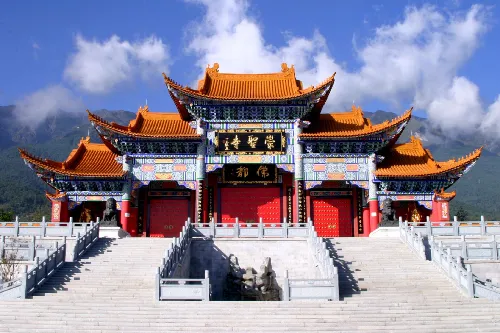
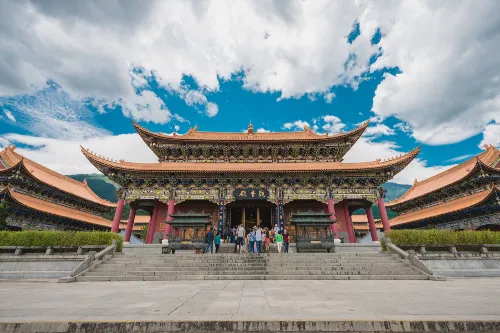
Nanzhao Jianji Giant Bell
The original bell was destroyed during the wars of the Xianfeng and Tongzhi periods of the Qing Dynasty and was recast in 1997. It is a typical Buddhist bell, with the bell body divided into upper and lower layers. The upper layer is decorated with six Paramita patterns. Weighing 16.295 tons, it is the largest bell in Yunnan Province and the fourth largest bell cast in modern China.
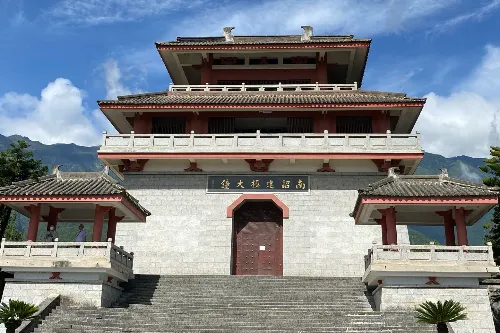
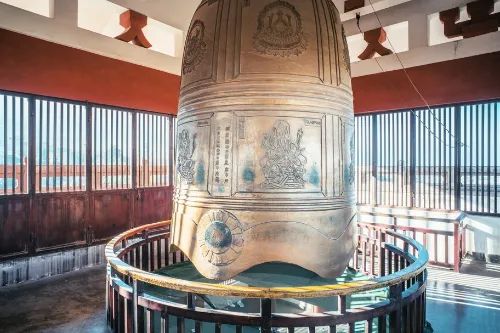
Yutong Guanyin Hall
The hall was expanded and reconstructed on its original site in 1999. It is 29.99 meters high, covering a land area of 8,100 square meters and a construction area of 4,384 square meters. The hall enshrines the Yutong Guanyin, Acarya Guanyin, Stone-Carrying Guanyin, Brahmin Monk Guanyin, and Water-Moon Guanyin statues. The recast Yutong Guanyin Statue is 12.6 meters tall, cast in bronze and gilded, weighing 11 tons. Its design features a unique style of the Dali region, with a male body and a female appearance.
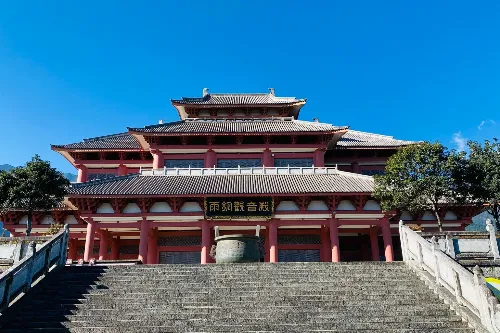
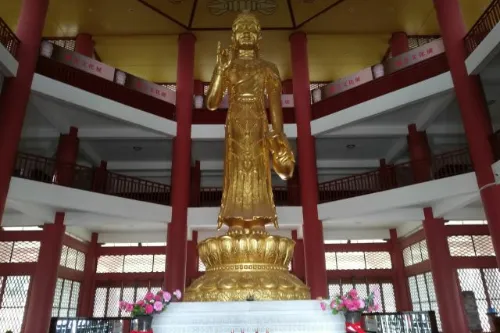
Three Pagodas Reflection Park
The park covers an area of 27 mu (approximately 1.8 hectares), with a water area of more than 10 mu (approximately 0.67 hectares). Facing south and backed by the Three Pagodas of Chongsheng Temple, the park gets its name from the clear reflection of the three pagodas in the pond within the park. The park's buildings include a couplet-engraved screen wall, a stele pavilion, and a rippling wave pavilion. It is planted with various exotic flowers and plants such as camellias, osmanthus fragrans, and azaleas.
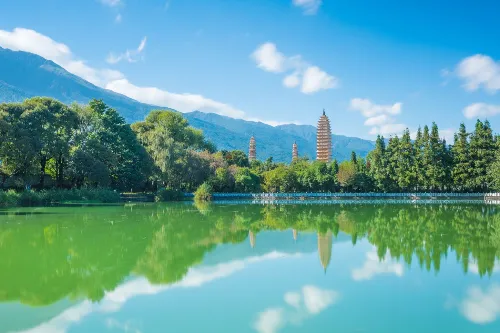
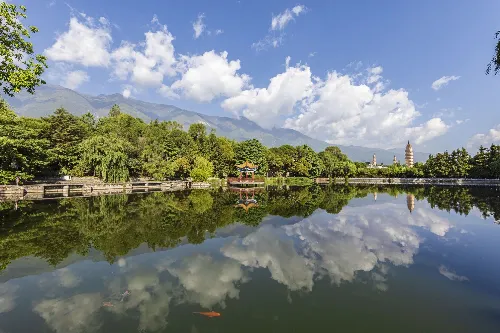
Prayer Wheels and Vajra Pestles
The prayer wheels can be rotated and are engraved with the Sutra of Peace, Heart Sutra of Prajnaparamita, Diamond Sutra, and Lotus Sutra. In ancient India, the vajra pestle was a weapon; after being introduced into Buddhism, it became a ritual tool for eliminating troubles and subduing demons. The largest vajra pestle is 6 meters long and 1 meter in diameter, and can be called the "King of Vajra Pestles".
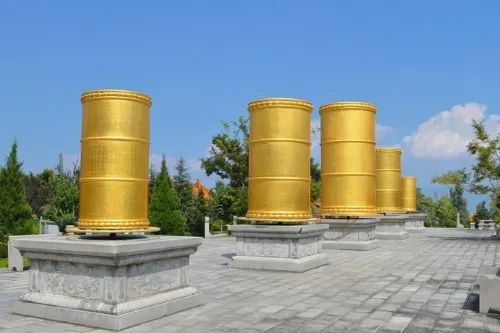

Tour Route
You can start your tour from the Three Pagodas in the front area to admire their grandeur, then visit the Nanzhao Jianji Giant Bell and Yutong Guanyin Hall to learn about the relevant historical culture. Next, go to Chongsheng Temple in the back area and visit the halls along the main central axis in sequence to experience the solemnity of Buddhist culture. Finally, you can go to the Three Pagodas Reflection Park to enjoy the beautiful reflection of the three pagodas. The entire tour takes about 3-5 hours, and you can adjust the schedule appropriately according to your time and interests.
Tour Suggestions
- It is recommended to visit on a sunny day so that you can better enjoy the beauty of the Three Pagodas and take photos.
- You can hire a scenic area guide during the tour to gain a deeper understanding of the scenic area's historical culture and the stories behind the attractions.
- Keep quiet in Chongsheng Temple and respect religious beliefs and cultural customs.
- You can bring some water and snacks to replenish energy during the tour.
Notes
- Abide by the scenic area's regulations; do not touch cultural relics casually or damage the scenic environment.
- When offering incense in the temple, follow the scenic area's rules, pay attention to safety, and prevent fires.
- If you choose to travel by bike, pay attention to traffic safety and abide by traffic rules.
- Take sun protection measures when visiting in summer, and keep warm in winter, as the temperature difference between morning and evening in Dali is relatively large.
Transportation
- Bus: You can take Bus No. 4 or the Three Pagodas Special Line and get off at Chongsheng Temple Three Pagodas Station.
- Taxi: Take a taxi from the ancient city of Dali or the urban area; the journey is short and convenient.
- Cycling: There are many bike rental points in the ancient city of Dali. You can rent a bicycle or electric bike to travel there, and enjoy the natural scenery of Dali along the way.
Opening Hours
The scenic area is open from 07:30 to 18:30. Please arrange your tour time reasonably to avoid missing the admission time.
Ticket Price
The reference ticket price is 75 yuan per person. You can search for the official WeChat public account of the scenic area "崇圣寺三塔文化旅游区" to get the latest updates or book tickets online.
Online Booking
Click here to jump to the Trip.com ticketing platform for ticket purchase.


